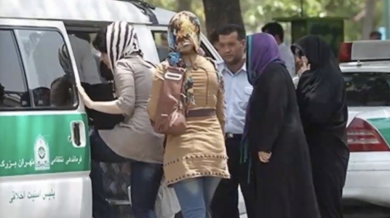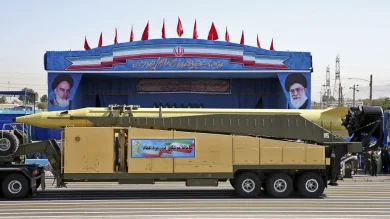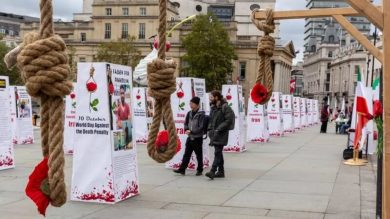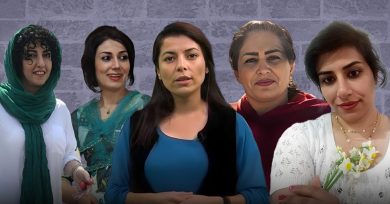In Iran, gender oppression is not merely a byproduct of conservative policies; it is a systematic tool of control enforced by the state’s most powerful institution, the Islamic Revolutionary Guard Corps (IRGC). Beyond its military, economic, and political influence, the IRGC plays a crucial role in maintaining the regime’s patriarchal control over Iranian women through mandatory hijab laws, surveillance, and widespread suppression of women’s rights.
The mandatory hijab is not just a piece of cloth—it symbolizes state control over women’s bodies, choices, and freedoms. The IRGC, alongside its paramilitary wing, the Basij militia, acts as the regime’s enforcer, ensuring compliance through violence, intimidation, and imprisonment. However, Iranian women continue to resist and challenge these oppressive policies, sparking a revolutionary movement with global resonance.
This opinion piece examines:
• How the IRGC enforces gender oppression,
• The impact of mandatory hijab laws on Iranian society,
• Women’s resistance to these repressive measures, and
• The global responsibility to stand in solidarity with Iranian women.
1. The Role of the IRGC in Gender Oppression
A. The Guardian of Patriarchy
The IRGC was formed in 1979 after Iran’s Islamic Revolution, not only to defend the regime militarily but also to enforce its ideological principles—many of which are deeply rooted in patriarchal norms. Among the IRGC’s primary objectives is the control of women’s public presence, ensuring that they adhere to Islamic dress codes and gender roles defined by the state.
The Basij militia, a paramilitary volunteer force under IRGC command, plays a key role in policing morality, especially concerning women. They patrol the streets, universities, workplaces, and public spaces, ensuring that women:
• Wear the hijab “properly.
• Avoid mixing freely with men.
• Comply with government standards of modesty in behavior and speech.
B. The Mandatory Hijab as a Tool of Control
The mandatory hijab law, imposed shortly after the 1979 revolution, became the cornerstone of gender oppression in Iran. The law demands that women cover their hair and bodies in public, with severe punishments for noncompliance, including:
• Arrest and imprisonment.
• Fines and public lashes.
• Denial of education and employment opportunities.
The IRGC frames the hijab as a religious and cultural obligation, but in reality, it serves as a political instrument that reinforces state control over women’s lives. The enforcement of the hijab symbolizes the regime’s power and its ability to dictate personal freedoms.
2. Beyond the Hijab: The IRGC’s Broader Agenda of Gender Suppression
While the mandatory hijab is the most visible aspect of gender oppression, the IRGC’s influence extends far beyond dress codes.
A. Suppression of Women’s Rights Activism
• Women who protest against discriminatory laws are often targeted by the IRGC.
• Prominent women’s rights activists such as Nasrin Sotoudeh and Narges Mohammadi have been imprisoned for their advocacy.
• The IRGC uses tactics of intimidation, including:
• Forced confessions broadcast on state TV.
• Harassment and imprisonment of family members.
• Travel bans to prevent activists from raising their voices internationally.
B. Gender Segregation Policies
The IRGC enforces gender segregation in:
• Public transportation.
• Universities and educational institutions.
• Sports stadiums, where women are barred from attending male sporting events.
These measures are intended to limit women’s participation in public life, reinforcing the notion that women belong in private spheres.
C. Restriction of Women’s Economic Opportunities
The IRGC controls a significant portion of Iran’s economy, including industries like construction, telecommunications, and energy. By limiting women’s access to employment in these sectors and supporting discriminatory laws, the IRGC ensures that economic power remains male-dominated.
Women face:
• Barriers to entrepreneurship and leadership roles.
• Workplace discrimination without legal recourse.
• Restrictions on working hours and environments, justified under the guise of “protecting women’s modesty.”
3. The Consequences of the IRGC’s Gender Policies
A. Deepening Gender Inequality
The IRGC’s gender policies have resulted in:
• Lower female labor force participation rates compared to global averages.
• Gender-based violence, including state-sanctioned harassment.
• Educational inequality, with women restricted from pursuing certain academic fields.
B. Psychological and Social Impact
The forced imposition of the hijab and other gender-based restrictions contribute to:
• Psychological trauma and depression among women.
• Social fragmentation, where women are systematically excluded from public decision-making.
• Generational trauma, as young girls grow up under a system that denies them autonomy.
C. International Isolation
Gender oppression contributes to Iran’s international isolation, with global human rights organizations and governments condemning the regime’s treatment of women. This further damages Iran’s global standing and reinforces economic sanctions that harm the broader population.
4. Resistance and Defiance: Iranian Women Fight Back
Despite decades of repression, Iranian women are defying the IRGC’s oppression with courageous acts of resistance that have inspired the world.
A. The Mahsa Amini Protests: A Turning Point
In September 2022, the death of Mahsa Amini, a 22-year-old woman arrested for “improper hijab,” ignited nationwide protests. The slogan:
“Women, Life, Freedom” (“Zan, Zendegi, Azadi”)
became the rallying cry for millions demanding an end to gender-based oppression.
These protests were led by women, who:
• Removed their hijabs publicly in defiance.
• Chanted slogans denouncing the regime and the IRGC.
• Faced brutal crackdowns, with many arrested, tortured, and killed.
B. Everyday Acts of Defiance
Resistance is not limited to mass protests; everyday acts are equally powerful:
• Refusing to wear the hijab in public spaces.
• Dancing and singing in public, activities banned for women.
• Driving alone without hijab, defying gender restrictions.
These actions, while seemingly small, are profound rejections of the IRGC’s control.
C. Digital Resistance
• Women have turned to social media to share their stories, using hashtags like #MyStealthyFreedom and #WhiteWednesdays.
• Activists like Masih Alinejad have created global platforms to amplify Iranian women’s voices.
• Despite IRGC cyber crackdowns, including internet blackouts and online surveillance, digital resistance continues to grow.
5. Global Implications: Why the World Must Care
The struggle of Iranian women is not just a domestic issue; it has global significance.
A. Women’s Rights Are Human Rights
The oppression of women in Iran represents a broader assault on human rights. Supporting Iranian women is part of the global fight for:
• Bodily autonomy.
• Freedom of expression.
• Gender equality.
B. Impact on Regional Stability
The IRGC’s gender policies are tied to its broader regional agenda, which promotes extremist ideologies that restrict women’s rights.
• A weakened IRGC means a weakened influence of oppressive regimes and militias in the region.
C. Inspiring Global Movements
Iranian women’s resistance has inspired global solidarity movements, demonstrating the power of collective action against authoritarianism.
6. The Way Forward: Global Solidarity and Action
A. Designate the IRGC as a Terrorist Organization
• The United States already classifies the IRGC as a terrorist group.
• The European Union, UK, and Canada must follow, ensuring that the IRGC’s financial networks are dismantled and its leaders are held accountable.
B. Support Iranian Women’s Voices
• Global media must continue to amplify the voices of Iranian women.
• Platforms and governments should provide safe digital spaces and tools for secure communication.
C. Expand Sanctions on Human Rights Violators
• Target IRGC leaders responsible for gender-based repression.
• Sanction businesses and organizations tied to the IRGC’s economic empire that funds oppression.
D. Provide Asylum and Protection for Activists
• Governments must provide asylum for fleeing activists.
• International organizations should offer legal support for imprisoned human rights defenders.
Conclusion: The Future Belongs to Iran’s Women
The IRGC’s gender oppression—rooted in control, fear, and violence—is being challenged like never before. Iranian women, through protests, digital activism, and everyday acts of defiance, are leading a revolution that demands not only gender equality but also freedom and dignity for all Iranians.
The mandatory hijab, once a symbol of the regime’s power, has now become a symbol of resistance. The world cannot turn away.
Join Our Newsletter!
Stay informed with the latest updates, news, and ways to take action in the fight for justice and global security. Sign up now to get updates delivered straight to your inbox!





